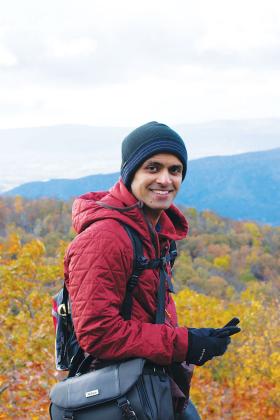A Solid Foundation: Jumping from Physics to GIS
Spring
2022
Member Spotlight
A Solid Foundation: Jumping from Physics to GIS
 “Astronomy was my gateway to physics,” says Kevin Cheriyan, a software developer who primarily focuses on creating GIS (geographic information systems) and geospatial applications. “Finding out about how the universe plays by natural and predictable laws and how the same laws (mostly) apply to bodies of all sizes—from entire galaxies and black holes to subatomic particles—made me hungry for more,” he said.
“Astronomy was my gateway to physics,” says Kevin Cheriyan, a software developer who primarily focuses on creating GIS (geographic information systems) and geospatial applications. “Finding out about how the universe plays by natural and predictable laws and how the same laws (mostly) apply to bodies of all sizes—from entire galaxies and black holes to subatomic particles—made me hungry for more,” he said.
Born in Kerala, India, Cheriyan moved to Brooklyn, New York, at age 12. He attended high school in Brooklyn and afterward did undergraduate studies at the University of Maryland, College Park (UMD). While at UMD, Cheriyan decided to major in physics and astronomy, and joined the Society of Physics Students in his sophomore year. “The community and support I found was encouraging and essential to staying sane in a tough program!” he says. “Taking part in outreach events with other students and engaging the public with liquid nitrogen demonstrations were important in conveying the relevance of science in everyday life.”
Cheriyan took on leadership roles with the UMD chapter and became an associate zone councilor at SPS National. “I had several important chances to influence how other students view the larger physics community,” he says. “I was part of a trip to Capitol Hill to meet with congressional staff and advocate for solutions to issues in science and science funding. Talking with congressional staffers and hearing their responses helped me gain some perspective about the need for physics to coexist with a million other fields and studies that also need federal funding and attention.”
Being inducted into Sigma Pi Sigma, Cheriyan says, was “a great honor, as it meant being part of a community that encouraged interest in physics and promoted service to others.” It also offered a lifetime of being part of a group with many shared interests.
While still an undergraduate, Cheriyan served as an assistant at the University of Maryland’s Cosmic Ray Energetics and Mass (CREAM) laboratory, supporting the building and testing of cosmic ray detectors used in high-altitude balloon flights from Antarctica and eventually for the International Space Station (ISS-CREAM). In addition to engineering and assembly support, Cheriyan tested various UNIX kernels and provided repair support to computers and other hardware used by researchers.
Then Cheriyan changed course. He had decided, somewhere along his undergraduate journey, that as fulfilling as the fields of physics and astronomy were, he wanted to focus on practical knowledge that could apply directly to industry after graduation.
“I was drawn to geography, and particularly its quantitative and technical side, because the University of Maryland’s Department of Geography was well known for its remote sensing research and faculty,” Cheriyan says. Remote sensing is the process of observing the physical characteristics of an area on Earth’s surface using reflected and emitted radiation from a distance. “The moment I realized that remote sensing of Earth’s surface is similar in principle to observational astronomy, which is just remote sensing on a larger, extraterrestrial scale, I was hooked.” In 2020 he received a master’s degree in geospatial information sciences from UMD.
Today, Cheriyan works at GeoMarvel, a GIS-focused software development company based out of Alexandria, Virginia. There, he uses development and IT tools to make various forms of location data available to clients, enabling them to access and analyze the data to make informed decisions. When not creating spatially aware applications, he also uses statistical techniques that are optimized for geospatial needs to identify patterns and relationships between variables and to visualize them on digital map products.
“I greatly enjoy the process of devising solutions to challenging problems, whether the challenges are created by data standardization issues, conversion errors between different coordinate systems, or finding user interface– or user experience–based solutions to interesting and unusual client requests,” he says.
Cheriyan says the skills he learned from physics and SPS were so important and fundamental that he applies them every day. “Whenever I encounter a difficult programming task, I reduce the problem to first principles, which can help [me] understand how the different parts are related,” he says. “I also find myself utilizing the communication skills I learned from doing physics outreach when needing to explain a technical concept to a client or project manager. If you can explain the conservation of angular momentum to middle schoolers, you can explain how asynchronous operations work in JavaScript to a client.”
To those looking to start their careers, Cheriyan advises not overlooking the importance of good communication and writing skills. “One can easily pick up most technical skills and concepts in a matter of weeks to basic proficiency levels,” he says, “but interpersonal skills are more challenging and can take a lifetime to perfect.”
And for those considering a major in physics, his advice is to avoid dismissing the importance of other sciences and the humanities. “There is a prevalent notion among physics majors and physicists that science is all physics or stamp collecting,” he says. “As a field that has considerable difficulty attracting and retaining underrepresented minorities, statements that amount to discounting the importance or difficulty of other sciences can turn potential students off from what could be a great time learning about physics and the natural world.”
Cheriyan offers one final piece of advice: “Take proper safety precautions when performing physics demonstrations, or you will end up with a disproportionately dry dominant hand that your doctor won’t believe is caused by you trying to demonstrate the Leidenfrost Effect by repeatedly sticking your hand in containers of liquid nitrogen.”
